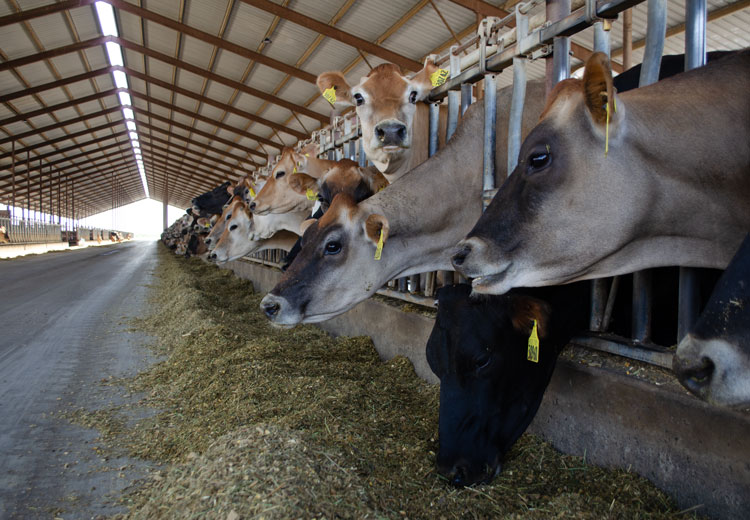
Having just wrapped up a phone call with a nutritionist regarding farm programs related to sustainability and carbon credits, the time is right to revisit the topic. I’ll follow in the footsteps of Penn State’s Alex Hristov here, and also acknowledge a personal bias. Hristov is a thought leader concerning dairy nutrition’s impact on sustainability. Case in point, I’ll direct you back to his recent Hoard’s Dairyman article, “We have tools to feed for fewer emissions” published in the July 2023 issue.
My further interest in the topic and personal bias stems from a commercial dairy research project I’m involved with regarding methane emissions. While we’ll get into the research in a bit, realize the demand for sustainably sourced milk and dairy products driven by consumers is not new. For example, quickly searching www.hoards.com for articles using the keyword “sustainability” showcases dozens of articles spanning over a decade.
With sustainability being covered for over 10 years, one might perceive this issue to be old news. Yet, new and emerging technologies and programs are hitting our industry regularly. Incentives and business opportunities offered through milk processors, vendors, and others within the dairy supply chain are aiming to boost the adoption of sustainable practices. In many cases, the programs also involve some accounting for carbon credits.
Within the past two months alone, through nutritionist and dairy connections, I’ve been exposed to several new programs being rolled out that are directed at dairy producers. This has been complicated to grasp. In addition to industry programs, the U.S. government is funding climate smart commodity grant programs directed toward sustainability. These programs are intended to provide incentives for producers to adopt sustainable practices or methods and cover many different agricultural commodities, including milk.
Different terminology
The terms “practices” or “methods” have struck me as slightly odd in dairy farm sustainability conversations. I’ve learned these terms can indicate management or feeding practices, as well as other agronomic amendments or feed supplements and technologies that have been documented to impact a farm’s sustainability measure. The process of documenting a practice or method relationship with emissions is anything but simple. Ideally, we’d measure methane emissions just like we do milk or component yield. However, directly measuring methane emissions on your farm is both cost- and labor-prohibitive.
I hope practical measurement tools are available in the future for accurate carbon accounting; however, for the moment we rely upon published research relationships like Hristov discusses in his writing.
Numerous factors involved
Over the past several months, I’ve been brushing up on the literature for impending research purposes. Another thought leader in dairy sustainability, Claudia Arndt, has helped guide me. What I’ve found is a wealth of insight. For example, the United Nations’ Intergovernmental Panel on Climate Change (IPCC) has written a 207-page chapter exclusively on livestock and manure emissions. Drilling down to ruminants and dairy cattle, an often-cited summary (Niu et al., 2018) lays out numerous different equations for predicting methane emissions.
In the absence of a deep dive into the research, this latter article highlights how animal body weight, dry matter intake, gross energy intake, diet composition, and energy-corrected milk or component yield are related to methane emissions. With these accepted relationships and equations in hand, we are in a position to manage methane emissions for commercial dairies toward improved sustainability.
Thinking about the impact factors, it’s apparent that these cow or diet-level impact factors also relate to feed conversion efficiency and profitability. Hence, we should be able to seek out practices that both mitigate methane emissions and also lead to feed conversion efficiency gains.
A win-win connection
In theory, when your cows convert more carbon from a pound of feed into milk or tissue, then less carbon will be lost to unproductive ends, such as methane production. This conversion of feed to milk is at some level in lockstep with feed conversion efficiency, and that’s my point here. The two diet composition factors impacting methane emission equations — dietary fiber and fat concentration — also influence feed conversion efficiency. So, balancing your diet around fiber and fat can influence both sustainability and profitability.
Admittedly, I’m overly simplifying the sustainability and feed conversion relationships here. Dairy diets can be balanced for fermentable fiber, starch, fatty acids, and more to impact both feed conversion and profitability. Yet, I believe we can make more noise about the fact we can balance diets for both financial and sustainable dairy performance.
Beyond diet composition, other practices and technologies are available to improve your farm’s sustainability, as Hristov discussed. Ask pertinent questions relating to your bottom line when your farm is presented with tools to manage methane emissions, such as the ones we covered in the February 2023 column titled “Sustainability is not a fad.” Ideally, your farm should source practices that will influence feed conversion as well as mitigate methane emissions. When we hit the mark for both, we have a winning solution and one that your farm can take to the bank while also meeting consumers’ desires.










